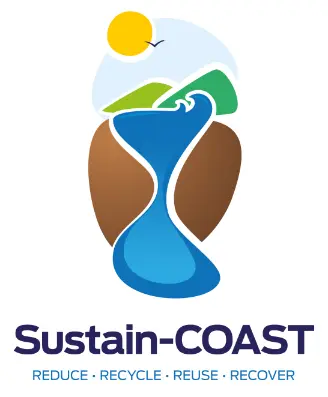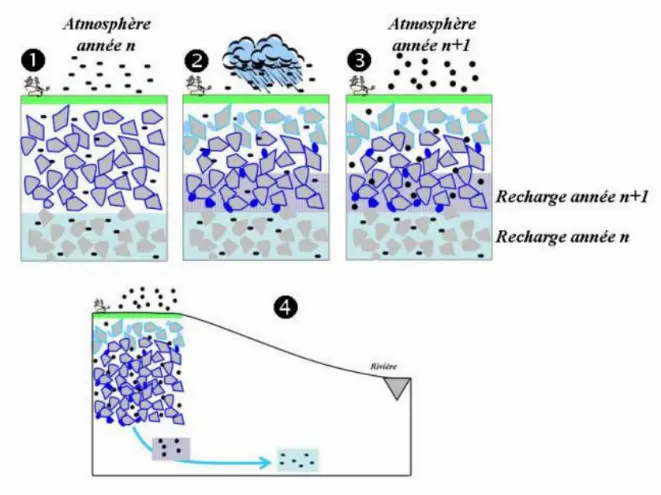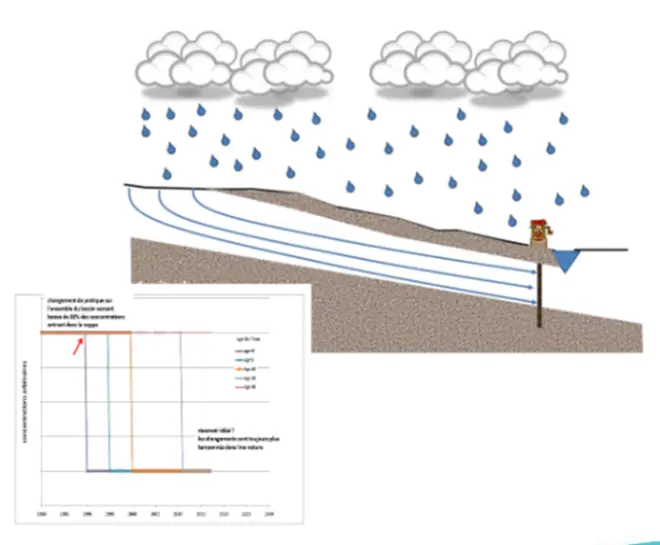The scientific community recommends a substantial improvement in the knowledge of aquifers, the establishment of reliable monitoring networks and a greater involvement of the administration and users to achieve a sustainable management of aquifers. The main objective...
AQUI-FR
AQUI-FR
national hydrogeological modeling platform (France)
AQUI-FR
Download the practice
People in charge of the innovative practice :
Jean-Pierre VERGNES – jp.vergnes@brgm.fr
AQUI-FR is a national hydrogeological modeling platform designed as a tool to valorize hydrogeological modeling work done in France. Started in 2014, AQUI-FR aims to bring together within a single digital platform hydrogeological models developed by different research institutes. AQUI-FR thus brings together 8 partners (ENS, CERFACS, BRGM, Ecole des Mines PARIS, Météo France, Géosciences Rennes, LHyges, UMR METIS) with the aim of developing a better knowledge of past, present, and future groundwater resources. AQUI-FR aims to implement forecasts of groundwater evolution in France, on time scales ranging from days to seasons (+6 months), and from atmospheric forecasts via standardized piezometric indicators. The platform also allows to carry out prospective modelling (up to 2100), based on hydrogeological modelling developed and used by water managers when they exist, and to promote the development of these modelling when they do not. A computer structure allows the association of 3 hydrogeological models (EROS, MARTHE, EauDyssée), a water and energy flow model (SURFEX), and an atmospheric analysis system (SAFRAN). The dynamic coupling of the models is provided by the OpenPALM coupler. The AQUI-FR platform is deployed on the operational machines of Météo-France and benefits from its support for daily monitoring. The platform has been used on a total of 14 distributed aquifer applications and 23 applications on karst systems. In the future, other regional models will be integrated to extend the spatial coverage.

Figure 1 : Concept of the AQUI-FR platform.
Responsible entity
Several entities are responsible for the AQUI-FR platform. The Geoscience department of the ENS is the coordinator of the platform.
Institutional setting
As the national model is built on existing hydrogeological applications, each partner remains the owner of its hydrogeological model and the results are available to the general public.
Geographical setting
The simulations from the platform cover 35% of metropolitan France. The EauDyssée model covers Basse-Normandie, Somme, Seine, Loire and four sub-systems: Marne-Loing, Marne-Oise, Seine-Eure, Seine-Oise. The MARTHE model covers Alsace, Basse-Normandie, Nord Pas-de-Calais, Poitou-Charentes, and Somme. Finally, the EROS model covers 23 karst systems (median size 99 km²).
Detailed explanation
The modeling platform represents the main hydrological processes occurring in watersheds, from precipitation to groundwater flow. In its current form, the AQUI-FR system includes three hydrogeological modeling software covering 11 sedimentary aquifers and 23 karst systems: the hydrogeological numerical platform EauDyssée, the MARTHE software and the EROS software used for karst systems. The three software are embedded in an application developed with the OpenPALM coupling syste.

All these models cover an area of about 149,000 km2 and contain up to 10 superimposed aquifer layers. AQUI-FR takes into account spatial heterogeneity by using different spatial scales. The SAFRAN meteorological analysis available over the French metropolitan area at a resolution of 8 km provides meteorological variables to the SURFEX land surface model that evaluates the water balance over the French metropolitan area. SAFRAN provides hourly precipitation (rain and snow), temperature, relative air humidity, wind speed and downward radiation. SURFEX uses these atmospheric variables to solve the surface energy and water balance at the land-atmosphere interface at a scale of 1-2 years and a time step of 5 minutes. SURFEX estimates the spatial distribution of flux between surface runoff and groundwater recharge on the SAFRAN. It accounts for different soil and vegetation types and uses a diffusion scheme to represent heat and water transfer through the soil. The soil in SURFEX is represented by a multilayer approach. Its depth varies according to the vegetation (in France from 0.2 to 3 m) and is partially accessible to plant roots. The infiltration of the soil at depth constitutes the recharge flow of the water table. Surface runoff can occur as a function of excess saturation or excess infiltration. The simulation of the watershed depends on its hydrogeological characteristics. For sedimentary basins, these two flows are transferred to the groundwater models MARTHE or EauDyssée. These models simulate transfer to the unsaturated zone, groundwater flows within and between aquifers, runoff to and in rivers, and river-aquifer exchanges. They also take into account the numerous groundwater withdrawals from river basins. The temporal resolution is daily, and the spatial resolution varies from 100 m to a maximum of 8,000 m. The depth of the deepest aquifer can locally reach about 1,000 m. It should be noted that the hydrogeological models could have been conventionally fed with precipitation, potential evapotranspiration, and temperature data from the SAFRAN analysis using their own water balance calculations. However, the combined use of SURFEX and SAFRAN provides a consistent set of hydro-meteorological data on an 8 km resolution grid over France, including groundwater recharge and surface runoff from SURFEX, as well as potential evapotranspiration, precipitation and temperature from SAFRAN. The use of these 8 km resolution flows from SURFEX necessitated recalibration of the hydrogeological models included in the platform. Karst aquifer systems are simulated by a conceptual reservoir modeling approach using EROS software. Each karst system is represented by a reservoir model at a daily time scale. Conceptual approaches are preferred for the simulation of karst systems. Indeed, their heterogeneities make it difficult to use a physics-based approach. EROS uses daily precipitation, snow, temperature and potential evapotranspiration provided by SAFRAN to calculate karst spring flows. Technically, the AQUI-FR hydrogeological modeling platform was developed using the OpenPALM coupling system, which allows easy integration of high-performance computing applications in a flexible and scalable manner. In the OpenPALM framework, applications are divided into elementary components that can exchange data. The AQUI-FR platform is an OpenPALM application that currently includes five components.
A preliminary step is performed to estimate groundwater recharge and surface runoff with SURFEX taking into account SAFRAN atmospheric forcing before launching OpenPALM. This preliminary step gives access to 60 years of daily groundwater recharge and runoff at a regular resolution of 8 km over the entire metropolitan area.
Historical overview
The objectives of the first phase (since 2014) was to show the feasibility of such a tool via the construction of the AQUI-FR computer structure and the first evaluations, as well as to ensure the legal possibilities of exploiting hydrogeological applications in operational, and finally, to identify the elements of interest for the water managers. The construction of the AQUI-FR structure required several steps: (i) to gather the hydrogeological models on the same computer structure that can be mobilized in operational use, (ii) to integrate the different hydrogeological applications available, (iii) to converge towards a homogeneous treatment on a national scale, via at least the use of a common atmospheric forcing, (iv) to recalibrate the applications to make them more compatible with this new forcing.
This work was accompanied by an effort to process the input and output data. An important aspect of the input data is the integration of groundwater withdrawals over the simulated periods, which are difficult to acquire over long periods and for recent periods (2-year delay). The management of output variables requires specific work, taking into account the variables of interest for managers (variable, depth or geological layer, estimation period, estimation domain) and numerical constraints (disk volumes, calculation time). In parallel, two development efforts were carried out, in order to: (i) include a representation of the basement aquifers, with numerical experiments carried out on the Brittany aquifers, and (ii) to allow a correction of the initial states of the aquifers by integrating the available piezometric data.
Evidence of benefits from implementation
The results of the AQUI-FR project confirm the feasibility of bringing together independent hydrogeological models developed in different research institutes in the same coupling platform. All these models were initially developed and calibrated over shorter periods with heterogeneous geological and meteorological databases, but the evaluation of the long-term simulations that has been carried out shows a good comparison with the observations available for the same period. It confirms the relevance of using the AQUI-FR as a tool for long-term impact studies.

Figure 3 : Standardized piezometric level index between observed (a) and simulated (b) piezometers.
The other advantage of this platform is in its modularity. The AQUI-FR platform encourages the development of groundwater modeling where it is lacking and, more generally, it has the potential to be a valuable tool for many applications in water resources management and in water quality studies. research, for example in climate change studies and seasonal forecasts
Replication potential in SUDOE region
The trigger for implementing the practice was the publication of the Explore 2070 project results, which showed a disparate analysis, and thus the idea emerged to harmonize the modeling results to make forecasts. From a technical point of view, few obstacles were encountered. The obstacles encountered were in relation to intellectual property. Indeed, it was necessary to reach an agreement on the sharing of the source code of the Marthe model to implement it on the Météo France platform. On the conceptual side, the models were not perfectly calibrated: some model outputs overlap. From an administrative point of view, it was necessary to convince the regions, because the hydrogeological models were developed within the regional entities of BRGM. Finally, from a functional point of view, the maintenance of the platform requires a permanent researcher per partner. The project was also able to benefit from subsidies (about 100 k€ / year).
Future outlook
In terms of evolution, the project offers several perspectives in terms of: (i) improvement of physical processes: better integration of basement and karst aquifers, and (ii) development: evolution of numerical codes and techniques.
This project also offers prospects for development outside of France, in the French overseas departments and territories, but also prospects within the framework of PEPR (One Water program).
In the future, other regional models will be included to extend the coverage of AQUI-FR (bedrock aquifers located in Brittany). A new modeling method based on a rainfall-runoff model will be used to provide upstream river flows as boundary conditions for the MARTHE models that require it. Finally, since errors in the initial conditions can significantly alter the skill of the forecast, studies dedicated to data assimilation to improve the initial state conditions are also performed in parallel.
Key points of the innovative method
> Multi-model numerical platform
> Daily to seasonal forecasts
> Prospective modeling (up to 2100)
Acknowledgements
The innovative practice was suggested by Jean-Pierre VERGNES (BRGM) who also participated in the interview.
References
Duchaine, F., Jauré, S., Poitou, D., Quémerais, E., Staffelbach, G., Morel, T., and Gicquel, L. (2015). Analysis of high performance conjugate heat transfer with the OpenPALM coupler, Comput. Sci. Discov., 8, 015003, https://doi.org/10.1088/17494699/8/1/015003, 2015.
Habets, F., Amraoui, N., Caballero, Y., Thiéry, D., Vergnes, J-P., Morel, T., Le Moigne, P., Roux, N., de Dreuzy, J-R., Longuevergne, L., Ackerer, P., Maina, F., Besson, F., Etchevers, P., Regimbeau, F., Viennot, P. (2017). Plate-forme de modélisation hydrogéologiques nationale AQUI-FR. Rapport final de 1ère phase 2014-2016. http://www.geosciences.ens.fr/wp-content/uploads/2019/07/Rapport_fin_phase1_Aqui-FR_VF.pdf
Habets, F., Amraoui, N., Caballero, Y., Thiéry, D., Vergnes, J-P., Morel, T., Le Moigne, P., Leroux, D., Roux, N., Courtois, Q., de Dreuzy, J-R., Ackerer, P., Besson, F., Etchevers, P., Regimbeau, F., Vincendon, B., Gallois, N., Viennot, P. (2018). Evolution de la ressource en eau souterraine passée, présente et future estimée par AQUI-FR. Rapport d’étape. http://www.geosciences.ens.fr/wp-content/uploads/2019/07/rapport_d_etape_AquiFR_Juil_2018.pdf
Masson, V., Le Moigne, P., Martin, E., Faroux, S., Alias, A., Alkama, R., Belamari, S., Barbu, A., Boone, A., Bouyssel, F., Brousseau, P., Brun, E., Calvet, J.-C., Carrer, D., Decharme, B., Delire, C., Donier, S., Essaouini, K., Gibelin, A.-L., Giordani, H., Habets, F., Jidane, M., Kerdraon, G., Kourzeneva, E., Lafaysse, M., Lafont, S., Lebeaupin Brossier, C., Lemonsu, A., Mahfouf, J.-F., Marguinaud, P., Mokhtari, M., Morin, S., Pigeon, G., Sal gado, R., Seity, Y., Taillefer, F., Tanguy, G., Tulet, P., Vincendon, B., Vionnet, V., and Voldoire, A. (2013). The SURFEXv7.2 land and ocean surface platform for coupled or offline simulation of earth surface variables and fluxes, Geosci. Model Dev., 6, 929–960, https://doi.org/10.5194/gmd-6-929-2013
Thiéry, D. (2015a). Code de calcul MARTHE – Modélisation 3D des écoulements dans les hydrosystèmes – Notice d’utilisation de la version 7.5 (MARTHE: Modeling software for groundwater flows), BRGM/RP-64554-FR, BRGM, Orléans.
Thiéry, D. (2018a). Logiciel ÉROS version 7.1 – Guide d’utilisation, Rapport final, BRGM/RP-67704-FR, BRGM, Orléans.
aquifer
news
Discover more on the Aquifer project news and on aquifer management
aquifer news
Description and objectives of the project
Information on the project
The Llobregat Delta Water Users' Community has designed recharge basins in Molins de Rei to recharge the Baix Llobregat aquifer. View of one of the reloading basins during the test phase The Llobregat Delta Water Users' Community is one of the nine partners in the...
Success stories in groundwater management
Compilation of groundwater management success stories completed. Throughout April, the 30 cases of innovative practices in groundwater management have already been selected by the clusters participating in the project: PPA, CWP and AV. The task started with the...
PROPOSE AN
INNOVATIVE PRACTICE
You are in charge of an innovative practice regarding aquifer management and you want to referenced it on the Aquifer platform ?
Fulfill the form and propose it to the Aquifer partners.
THE EBOOK
Aquifer offers a range of innovative water management practices. You can download all our fact sheets here.
e-book of innovative practices
DOCUMENTATION
To go further on information related to the management of aquifers







